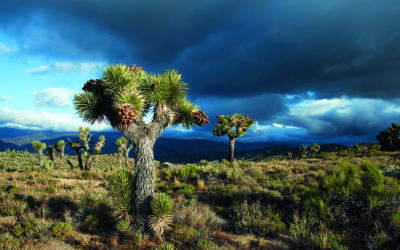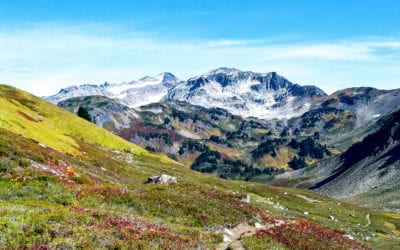View of the Three Sisters. Photo credit © Alexander Kingsbery
Foundation and Future of Long Distance Trails
Editorial Perspectives
August 2020 | Volume 26, Number 2
“In order to assure that an increasing population, accompanied by expanding settlement and growing mechanization, does not occupy and modify all areas within the United States and its possessions, leaving no lands designated for preservation and protection in their natural condition, it is hereby declared to be the policy of the Congress to secure for the American people of present and future generations the benefits of an enduring resource of wilderness… for the use and enjoyment of the American people in such manner as will leave them unimpaired for future use and enjoyment as wilderness, and so as to provide for the protection of these areas, the preservation of their wilderness character” Wilderness Act, 1964
“In order to provide for the ever-increasing outdoor recreation needs of an expanding population and in order to promote the preservation of, public access to, travel within, and enjoyment and appreciation of the open-air, outdoor areas and historic resources of the Nation, trails should be established…to provide for maximum outdoor recreation potential and for the conservation and enjoyment of the nationally significant scenic, historic, natural, or cultural qualities of the areas through which such trails may pass.” National Trails System Act, 1968
We begin this special edition of the International Journal of Wilderness with references to the U.S. Wilderness and National Trails System Acts to illustrate the significance and interconnectedness of wilderness areas and long-distance trails. Wilderness areas preserve places in an undeveloped, natural, and untrammeled state to provide primitive and unconfined recreation opportunities. National Scenic Trails provide recreation opportunities, including opportunities for long-distance travel, and protect the natural, scenic, cultural, and historic characteristics of the lands they traverse. In philosophy and legislative intent, these designations are similar, emphasizing high-quality resource protection and provision of unique recreation opportunities. In application, they are administered by the US federal agencies and often share common geographies (i.e., national scenic trails often travel through designated wilderness areas).
Difficulties in the management of resources and recreation along national scenic trails in wilderness areas have, however, arisen. These difficulties, often ignited by increases or changes in visitor use have revealed tensions, inconsistencies, and disconnects between wilderness and National Scenic Trail management. The purpose of this special edition is to both highlight the issues particular to resource and recreation management when wilderness and National Scenic Trails overlap and to advance dialogue, collaboration, and science-informed management of these special places.
National Scenic Trails
National Scenic Trails (NST), along with National Historic Trails (NHT) and National Recreational Trails (RHT), were established by the National Trails System Act of 1968 (Figure 1). The basic criteria, as specified by the Act (16 USC 1241-51), is minimum length of 100 miles, continuity along an established route (although the route need not physically exist in its entirety), primarily non-motorized use, and the presence of outstanding recreational opportunities. Currently, 11 trails hold the National Scenic Trail designation in the United States, totaling nearly 20,000 miles (Table 1). NHTs commemorate historic (and prehistoric) routes of travel that are of significance to the entire United States. They must meet all three criteria listed in Section 5(b)(11) of the National Trails System Act. NHTs are established by an act of the US Congress. NRTs are existing regional and local trails recognized by either the US Secretary of Agriculture or the US Secretary of the Interior upon application.
Given the growing popularity of thru-hiking and extended trails, there is a critical need for in-depth research and discussion to strengthen the understanding and management of this unique recreational activity and the diverse and transboundary resources that are encompassed by long-distance trails. Currently, there are limited studies on long-distance trail use and extended trail management and most studies focus on a select few trails, such as the Appalachian or Pacific Crest Trail, revealing a gap in the literature and coordinated approaches to management. Growing popularity and limited available science is not limited to US long-distance trails and their use, it is also critical research and management gap for similar trails around the world.
This special edition in the International Journal of Wilderness will address these gaps and expand the research and discussion on thru-hiking and extended trails to the academic and professional community. We include research and perspectives on a variety of extended trails in the U.S. and international settings as well as a diversity of types of trails from highly populated to more remote. Further, we address a vast amount of critical and relevant topics to provide readers with conceptual content and practical implications.
The special edition starts with the Soul of the Wilderness where Beth Boyst shares the opportunities and benefits of collaboration and a shared vision and stewardship for National Scenic Trails (NSTs) and wilderness Areas. Next, Cerveny, Derrien, and Miller provide a foundation for understanding the evolving role of partners in the shared stewardship of National Scenic Trails. Reigner and Wimpey discuss key insights on how collaboration can inform multi-jurisdictional management through examples of the Pacific Crest National Scenic and John Muir Trails. Then, Cole and Thomsen provide findings of social aspects of the thru-hiker experience before, during, and after the completion of the Pacific Northwest National Scenic Trail and how this social experience influences hike preparation, response to challenges during the hike, and the transition back to everyday life.
Stelson, Rice, and Taff share findings from a culturally significant trail through the Katmai Wilderness to discuss the importance of considering cultural resources in long-distance trail planning and management Then, Rogers and Leung provide findings for how emerging technologies create opportunities and challenges for managers and recreationists of the Appalachian Trail and how this information can inform spatial decisions. Finally, Cunha et al. offer an international perspective on the growth and evolution of the Brazilian long-distance trail system, the involvement of diverse groups, and challenges facing the future.
Bigart’s book review of a recently published The Unlikely Thru-Hiker by Derick Lugo highlights the unique perspective of the author as an African-American thru-hiker with no previous outdoor experience on his Appalachian Trail journey. The review offers key insights to how thru-hiking can be a more inclusive and diverse type of recreation and the impacts of these immersive experiences.
As editors of this special edition, it is our hope that the articles can serve as a catalyst for future research and management discussions. In particular, we propose the following calls to action: (1) longitudinal studies to better understand the thru-hiker experience and long-term impacts; (2) focus on cultural resource impacts and management; (3) system-wide studies that can assess trends and unique aspects of National Scenic Trails; (4) coordination and communication across agency and international contexts; (5) expansion of studies to less-frequented trails and trails with unique attributes; (6) studies and experimentation of technology use and social media for thru-hikers and managers; (7) diversification of participation and perspectives of thru-hiking; (8) understanding role of trail towns and communities in management, stewardship, and hiker experience.
About the Authors
JENNIFER THOMSEN is an assistant professor in the Parks, Tourism, Recreation Management Program at the University of Montana; email: jennifer.thomsen@mso.umt.edu
JEREMY WIMPEY, PhD, is Principal of Applied Trails Research and an adjunct faculty member in the Forest Resources and Environmental Conservation Department at the Virginia Polytechnic Institute and State University; email: jeremyw@appliedtrailsresearch.com.
NATHAN REIGNER, PhD, is a research assistant professor in the Recreation, Park, and Tourism Management Department at the Pennsylvania State University; email: npr5097@psu.edu.
Read Next
With Collaboration We Can Overcome Challenges Together
The concepts of “shared stewardship” or “collaborative management” can be challenging. They require shared vision, definition of clear roles and responsibilities, and commitment to the collaborative process.
Shared Stewardship and National Scenic Trails: Building on a Legacy of Partnerships
National Scenic Trails connect people with the natural and cultural heritage of the United States. Theses trails also provide important opportunities for agencies to engage partners in trail stewardship and sponsorship.
Multi-jurisdictional collaborative management of the Pacific Crest, National Scenic, and John Muir Trails
Information about visitor use in parks and protected areas is an essential component of effective management.





